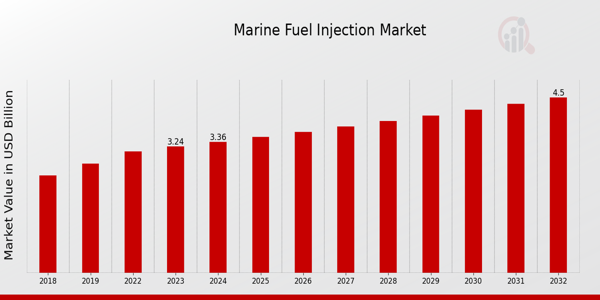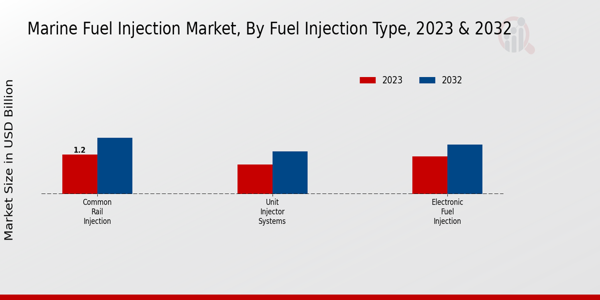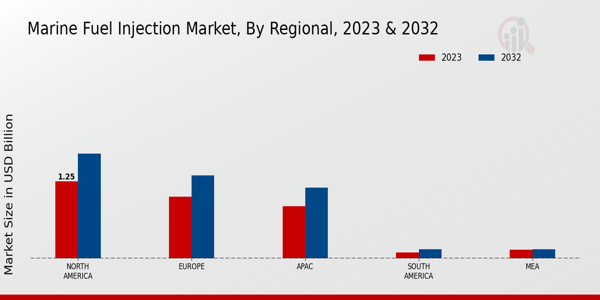Marine Fuel Injection Market Overview
The Marine Fuel Injection Market Size was estimated at 3.12 (USD Billion) in 2022. The Marine Fuel Injection Market is expected to grow from 3.24 (USD Billion) in 2023 to 4.5 (USD Billion) by 2032. The Marine Fuel Injection Market CAGR (growth rate) is expected to be around 3.72% during the forecast period (2024 - 2032).

Source Primary Research, Secondary Research, MRFR Database and Analyst Review
Key Marine Fuel Injection Market Trends Highlighted
The growing emphasis on environmental rules and the requirement for fuel efficiency in vessels have a significant impact on the marine fuel injection market. Advanced fuel injection systems are in greater demand as the marine and maritime sectors strive to lower emissions and adhere to stringent international regulations.
Manufacturers are compelled to innovate and create more effective solutions due to the increasing demand for engine performance and fuel optimization. Players in this market are also investing in research and development to improve performance while reducing environmental impact, with a focus on cleaner fuels and technologies.
The maritime fuel injection industry has numerous potential prospects. Businesses can broaden their product offerings and align with sustainability goals by switching to alternative fuels like LNG and biofuels.
Additionally, the increasing adoption of smart technologies, including automation and IoT in marine operations, creates a demand for more sophisticated fuel injection systems.
Companies that can integrate these advanced technologies into their designs position themselves advantageously in a competitive landscape. Recent trends show a noticeable shift toward more sustainable practices within the industry.
Innovations in fuel technology, such as hybrid systems and more efficient engine designs, are gaining traction as ship owners look to reduce their carbon footprint while maintaining operational efficiency.
Furthermore, digitalization is reshaping the sector, allowing for real-time monitoring and improved decision-making related to fuel usage. This holistic approach not only meets regulatory demands but also enhances overall operational performance, paving the way for future advancements in the marine fuel injection market.
Marine Fuel Injection Market Drivers
Increasing Demand for Fuel Efficiency in Marine Vessels
One of the most significant drivers of growth in the Marine Fuel Injection Market is the increasing demand for fuel efficiency in marine vessels. Ship owners are continuously seeking ways to optimize their fuel consumption to reduce operating costs and minimize their environmental impact.
With rising fuel prices and stringent regulations on emissions, there is a growing emphasis on the development and implementation of advanced fuel injection systems that offer better atomization and combustion efficiency.
These systems not only improve fuel efficiency but also ensure compliance with international environmental regulations, such as those set by the International Maritime Organization (IMO). The push for greener technologies fuels innovation in the Marine Fuel Injection Market, prompting manufacturers to develop sophisticated fuel injection technologies that can deliver higher performance and lower emissions.
Moreover, the competitive nature of the marine industry means that operators are always looking for ways to enhance their operational efficiency to remain competitive.
The expansion of trade and the increasing number of container ships add to the demand for advanced marine fuel injection systems. As the fleet modernizes, the adoption of high-performance fuel injection technologies is likely to grow significantly.
This situation is further exacerbated by the increasing trend of retrofitting older vessels with modern fuel injection solutions. Overall, the push for enhanced fuel efficiency is a key factor propelling the growth of the Marine Fuel Injection Market and is expected to remain a crucial driver in the foreseeable future.
Regulatory Compliance and Environmental Standards
The increasing stringency of environmental regulations and standards is a prominent driver in the Marine Fuel Injection Market. Governments and international bodies are implementing tighter emission controls to combat climate change and pollution from maritime activities.
This has led to the introduction of advanced fuel injection systems that can significantly reduce nitrogen oxides (NOx), carbon dioxide (CO2), and particulate matter emitted by marine vessels.
Compliance with these regulations is essential for ship operators to avoid penalties and to ensure their vessels remain operational within various jurisdictions. Consequently, the need for fuel injection technologies that are capable of meeting these regulatory requirements has accelerated growth in the market.
Technological Advancements in Fuel Injection Systems
Technological advancements in fuel injection systems are driving the growth of the Marine Fuel Injection Market. Innovations such as electronic fuel injection (EFI), common rail fuel injection systems, and enhanced nozzle designs are leading to better engine performance and lower emissions.
These technologies allow for precise fuel delivery, improved combustion efficiency, and enhanced control over fuel usage. As marine vessel designs evolve and as the demand for efficient fuel systems increases, manufacturers are investing heavily in research and development to deliver cutting-edge injection technologies that meet the modern needs of ship operators.
Marine Fuel Injection Market Segment Insights
Marine Fuel Injection Market Fuel Injection Type Insights
The market segmentation based on Fuel Injection Type revealed intricate details about its various components. The Common Rail Injection system held a majority share within the market, valued at 1.2 USD Billion in 2023 and projected to reach 1.7 USD Billion by 2032. Its significance stemmed from its ability to enhance fuel efficiency and reduce emissions, making it a critical component in the effort to align with environmental standards.
Following this, the Unit Injector Systems segment, valued at 0.9 USD Billion in 2023, is expected to increase to 1.3 USD Billion by 2032. This system's design allowed for precise fuel delivery, which contributes to improved engine performance and fuel economy, thereby emphasizing its importance in the overall market landscape.
Additionally, Electronic Fuel Injection, valued at 1.14 USD Billion in 2023 and projected to grow to 1.5 USD Billion by 2032, served as a critical technological advancement that optimized ignition timing and fuel delivery, ensuring the engine operates efficiently under varied conditions.
This segment showcased how technology continues to drive innovation within the Marine Fuel Injection Market, addressing both performance and regulatory demands. These figures underscored the substantial growth expectations within the market as it adapts to the challenges and opportunities arising in the maritime industry, all while focusing on sustainability and efficiency.
Furthermore, the diverse applications of these fuel injection types highlighted ongoing trends toward modernization and adherence to environmental regulations, driving investment and development in cleaner fuel technologies.
Overall, the analysis of this segmentation within the Marine Fuel Injection Market revealed a dynamic environment influenced by technological advancements, regulatory frameworks, and the continuous need for improvements in fuel efficiency and emission reductions.

Source Primary Research, Secondary Research, MRFR Database and Analyst Review
Marine Fuel Injection Market Engine Type Insights
The Engine Type segment plays a vital role within this market, encompassing various types such as Two-Stroke Engines, Four-Stroke Engines, and Dual-Fuel Engines. Two-stroke engines are known for their efficiency and power output, often favored in large vessels where weight considerations are crucial. Four-stroke engines, on the other hand, are widely used due to their suitability for a range of applications, balancing fuel efficiency and operational flexibility.
Dual-Fuel Engines are gaining traction as they allow vessels to switch between fuel types, thus offering significant operational cost savings and environmental benefits. The growing emphasis on fuel efficiency and stringent emission regulations drives innovation across these engine types, directly influencing the Marine Fuel Injection Market revenue.
Overall, market growth is further supported by advancements in technology and a rising demand for efficient and environmentally friendly marine transportation solutions.
Marine Fuel Injection Market Vessel Type Insights
The Marine Fuel Injection Market has shown consistent growth in the Vessel Type segment, which encompasses various categories, including Commercial Vessels, Fishing Vessels, Military Vessels, and Pleasure Crafts.
Commercial Vessels, which include cargo ships and tankers, are significant contributors, often reflecting a majority holding in market revenue due to high operational needs. Fishing Vessels have also gained traction, driven by the growing demand for seafood and welfare concerns around sustainability practices.
Military Vessels display a steady demand as the need for advanced marine technology continues to rise, resulting in increased investments in marine fuel injection systems. Furthermore, Pleasure Crafts caters to the recreational segment, highlighting a shift towards leisure activities on the water, which positively affects the market trends.
The overall Marine Fuel Injection Market data suggest a robust environment driven by these key segments, with each playing a critical role in shaping market growth. The diverse applications and requirements in these vessel categories offer numerous opportunities for innovation and technological advancement within the industry.
Marine Fuel Injection Market Application Insights
The Marine Fuel Injection Market plays a crucial role in maritime operations through its various applications, notably in power generation, propulsion, and auxiliary systems.
Power generation remains a significant area, as efficient fuel injection systems enhance performance and reduce emissions, aligning with environmental standards. Propulsion applications dominate the market due to the increasing demand for high-efficiency engines that meet regulatory requirements for fuel consumption and emissions.
Auxiliary systems, essential for vessel operations, ensure reliability and efficiency, contributing to overall performance. The growth in the shipping industry, driven by international trade and energy needs, fosters opportunities within these application areas.
However, challenges such as the need for technological advancements in fuel injection systems and compliance with stringent regulations can impact market dynamics. The Marine Fuel Injection Market statistics indicate a robust growth trajectory, highlighting the importance of innovation in addressing these challenges.
As the market continues to evolve, understanding the specific applications of fuel injection systems will be key to leveraging the potential within the marine industry.
Marine Fuel Injection Market Regional Insights
The Marine Fuel Injection Market exhibited significant revenue generation across various regions, with North America holding the majority with a value of 1.25 USD Billion in 2023, projected to grow to 1.7 USD Billion by 2032, demonstrating its dominance in the industry. Europe followed closely, valued at 1.0 USD Billion in 2023 and expected to reach 1.35 USD Billion by 2032, highlighting its significant involvement in marine fuel injection technologies.
The APAC region, valued at 0.85 USD Billion in 2023 and anticipated to grow to 1.15 USD Billion by 2032, represented a crucial area due to its expanding shipping activities and technological advancements.
South America, while smaller in comparison, showed potential with a market value of 0.1 USD Billion in 2023, increasing to 0.15 USD Billion by 2032, indicating emerging growth opportunities.
Lastly, the MEA region was valued at 0.14 USD Billion in 2023, expected to increase slightly to 0.15 USD Billion by 2032, emphasizing its developing maritime industry.
These variations in the Marine Fuel Injection Market segmentation reflected different growth drivers, trends, and opportunities that each region presented.

Source Primary Research, Secondary Research, MRFR Database and Analyst Review
Marine Fuel Injection Market Key Players and Competitive Insights
The Marine Fuel Injection Market is characterized by a dynamic landscape where technological advancements, regulatory pressures, and competitive strategies converge to shape industry trends. Key players in this market are increasingly focused on enhancing their product offerings, optimizing fuel efficiency, and complying with stringent environmental regulations.
The market is influenced by the growing demand for high-performance marine engines, the advent of alternative fuels, and the ongoing push toward sustainability in maritime operations. Companies are engaging in strategic collaborations, mergers and acquisitions, and innovations in fuel injection systems in order to gain a competitive edge and cater to the evolving needs of maritime operators.
Cummins stands out in the Marine Fuel Injection Market with a strong presence attributed to its extensive range of fuel injection systems designed for marine applications. The company's commitment to engineering excellence and innovation enables it to provide high-performance, reliable, and efficient fuel injection solutions that meet the rigorous demands of marine operations.
Cummins invests substantially in research and development to advance technology in fuel injection, ensuring that their products contribute to reduced emissions and enhanced fuel efficiency. Their established reputation for quality, backed by a service network, provides significant advantages, allowing customers to have confidence in the performance and durability of Cummins' offerings in the marine sector.
Bharat Forge is a key player in the Marine Fuel Injection Market, recognized for its technological prowess and commitment to innovation. The company leverages its expertise in manufacturing to deliver premium fuel injection components, which are critical to the efficiency and performance of marine engines.
Bharat Forge focuses on integrating advanced technologies into its products, enabling it to produce lightweight and robust fuel injection systems that comply with modern maritime standards. The company's strong emphasis on quality assurance and operational excellence positions it favorably within the market, allowing Bharat Forge to cater to a diverse range of customers and establish itself as a trusted provider of marine fuel injection solutions.
Key Companies in the Marine Fuel Injection Market Include
- Cummins
- Bharat Forge
- Siemens
- Alfa Laval
- Kongsberg Gruppen
- Robert Bosch
- Honeywell
- Yanmar
- MAN Energy Solutions
- Mitsubishi Heavy Industries
- Emerson
- Wärtsilä
- Caterpillar
- Volvo Penta
- Rolls-Royce
Marine Fuel Injection Market Developments
Recent developments in the Marine Fuel Injection Market have been characterized by advancements aimed at improving efficiency and reducing emissions. Companies such as Wärtsilä and MAN Energy Solutions are focusing on innovative fuel injection systems to enhance the performance of marine engines while complying with stringent environmental regulations.
Additionally, Siemens and Emerson have been investing in digital technologies to optimize fuel management and reduce operational costs in marine applications. The market has also experienced notable growth, with companies like Honeywell and Alfa Laval reporting increases in demand for their marine fuel injection products, directly impacting their market valuation positively.
Furthermore, some key players, including Cummins and Mitsubishi Heavy Industries, have been actively pursuing strategic partnerships to expand their product offerings and market reach. While there have been discussions around potential mergers and acquisitions, no significant announcements have been made recently.
Overall, the emphasis on sustainability and technological innovation continues to shape the landscape of the Marine Fuel Injection Market, reinforcing the competitive positions of prominent companies such as Robert Bosch, Volvo Penta, and Rolls-Royce.
Marine Fuel Injection Market Segmentation Insights
Marine Fuel Injection Market Fuel Injection Type Outlook
- Common Rail Injection
- Unit Injector Systems
- Electronic Fuel Injection
Marine Fuel Injection Market Engine Type Outlook
- Two-Stroke Engine
- Four-Stroke Engine
- Dual-Fuel Engine
Marine Fuel Injection Market Vessel Type Outlook
- Commercial Vessels
- Fishing Vessels
- Military Vessels
- Pleasure Crafts
Marine Fuel Injection Market Application Outlook
- Power Generation
- Propulsion
- Auxiliary System
Marine Fuel Injection Market Regional Outlook
- North America
- Europe
- South America
- Asia Pacific
- Middle East and Africa
|
Attribute/Metric
|
Details
|
|
Market Size 2022
|
3.12(USD Billion)
|
|
Market Size 2023
|
3.24(USD Billion)
|
|
Market Size 2032
|
4.5(USD Billion)
|
|
Compound Annual Growth Rate (CAGR)
|
3.72% (2024 - 2032)
|
|
Report Coverage
|
Revenue Forecast, Competitive Landscape, Growth Factors, and Trends
|
|
Base Year
|
2023
|
|
Market Forecast Period
|
2024 - 2032
|
|
Historical Data
|
2019 - 2023
|
|
Market Forecast Units
|
USD Billion
|
|
Key Companies Profiled
|
Cummins, Bharat Forge, Siemens, Alfa Laval, Kongsberg Gruppen, Robert Bosch, Honeywell, Yanmar, MAN Energy Solutions, Mitsubishi Heavy Industries, Emerson, Wärtsilä, Caterpillar, Volvo Penta, RollsRoyce
|
|
Segments Covered
|
Fuel Injection Type, Engine Type, Vessel Type, Application, Regional
|
|
Key Market Opportunities
|
Rising shipping industry demand, Technological advancements in fuel efficiency, Emphasis on emission reduction regulations, Expansion of alternative fuel options, Increasing investments in marine infrastructure
|
|
Key Market Dynamics
|
Technological advancements, Environmental regulations, Demand for fuel efficiency, Growth in the shipping industry, Rising marine transportation activities
|
|
Countries Covered
|
North America, Europe, APAC, South America, MEA
|
Marine Fuel Injection Market Highlights:
Frequently Asked Questions (FAQ) :
The Marine Fuel Injection Market is expected to be valued at 4.5 USD Billion in 2032.
The anticipated CAGR for the Marine Fuel Injection Market from 2024 to 2032 is 3.72%.
North America is expected to dominate the Marine Fuel Injection Market with a value of 1.7 USD Billion by 2032.
The projected market value for Common Rail Injection is expected to reach 1.7 USD Billion by 2032.
The value of the Unit Injector Systems segment is expected to reach 1.3 USD Billion in 2032.
Key players in the Marine Fuel Injection Market include companies such as Cummins, Wärtsilä, and Robert Bosch.
The market size for Electronic Fuel Injection is projected to be 1.5 USD Billion in 2032.
The expected market size for the Asia-Pacific region is projected to be 1.15 USD Billion in 2032.
Challenges in the Marine Fuel Injection Market include technological advancements and regulatory compliance.
The anticipated market value for the South American region is expected to be 0.15 USD Billion in 2032.

















